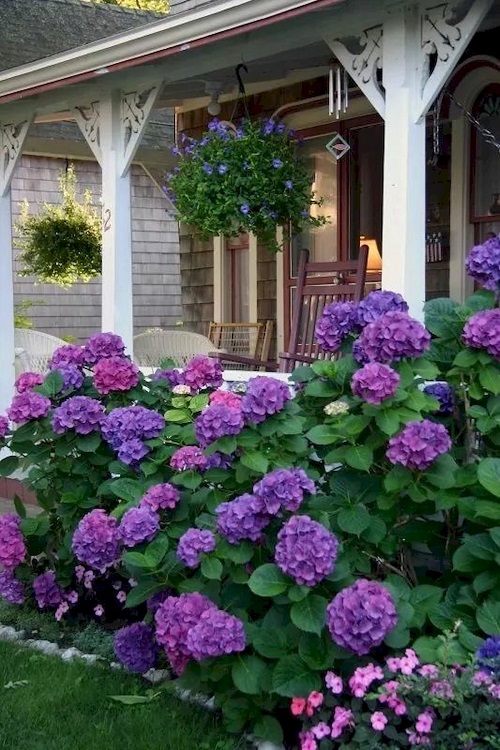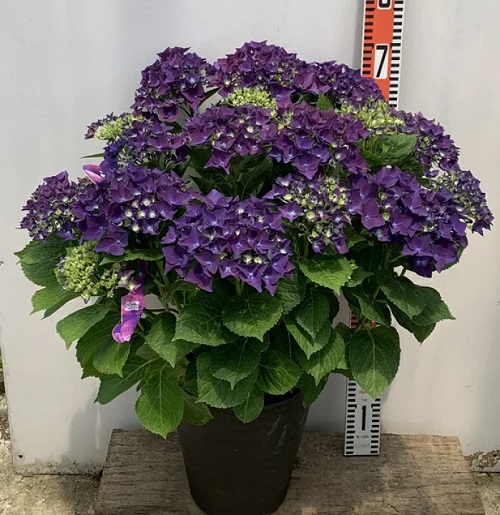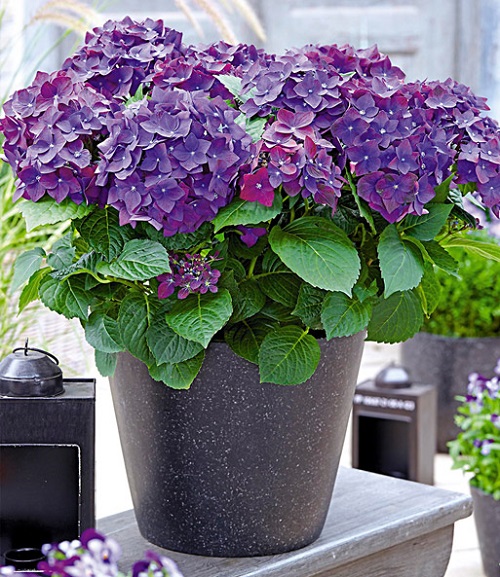Here’s everything about growing Purple Hydrangeas along with details on How to Make Your Hydrangea Purple!
Purple Hydrangeas surely catch everyone’s eyes with their vivid hue. In this article, we will have a look at the trick on How to Make Your Hydrangea Purple!
Find What Side of the House You Plant Hydrangeas here
What is Purple Hydrangea?

Purple hydrangeas are hydrangea varieties that naturally produce flowers in shades of purple. There are several specific varieties of hydrangeas known for their purple flowers, and they have been bred or developed to exhibit this color. Some of the best ones are:
- Hydrangea macrophylla ‘Endless Summer – The Original’: This variety produces large mophead flowers that can range in color from deep purple to lavender, depending on soil pH and other factors. It is a repeat bloomer, meaning it can produce flowers throughout the growing season.
- Hydrangea macrophylla ‘Nikko Blue’: ‘Nikko Blue’ is a classic hydrangea with large, rounded flower clusters that often start out as pink or purple and mature to a deep blue or purple color. The flowers are known for their intense and vibrant color.
- Hydrangea macrophylla ‘Amethyst’: ‘Amethyst’ hydrangeas produce clusters of deep purple flowers. This variety is known for its rich color and compact growth habit, making it suitable for smaller gardens or containers.
- Hydrangea macrophylla ‘Pia’: ‘Pia’ is a dwarf hydrangea variety that showcases vibrant purple flowers. It is a compact plant that reaches a maximum height of around 2 feet, making it perfect for small spaces or container gardens.
- Hydrangea macrophylla ‘Forever and Ever – Peppermint’: This variety features unique, bicolored flowers that transition from purple to white. The flowers have purple edges with white centers, creating a striking visual effect.
Here are the Best Types of Purple Hydrangea Varieties
How to Grow Purple Hydrangea
Here are some quick tips and tricks for growing and maintaining purple hydrangeas:
1. Location
Plant your purple hydrangeas in an area that receives morning sun and afternoon shade. They prefer dappled sunlight or filtered light rather than direct, intense sunlight. Avoid planting them in hot, dry locations.
2. Soil
Purple hydrangeas thrive in rich, well-draining soil. Ensure the soil is amended with organic matter such as compost or well-rotted manure to improve drainage and fertility.
Here are the best recipes to make the perfect growing medium for your plants
3. Watering
Hydrangeas require regular watering, especially during hot and dry periods. Keep the soil consistently moist but not waterlogged. Mulching around the base of the plants can help retain moisture and regulate soil temperature.
Here are the best ways to water plants
4. Fertilization
Feed your purple hydrangeas with a balanced, slow-release fertilizer formulated for flowering shrubs in early spring. Follow the package instructions for application rates. Avoid over-fertilization, as it can lead to excessive leaf growth and fewer flowers.
Here are Effective Homemade Lawn Fertilizers That Are Safe From Hazardous Chemicals
5. Pruning
Prune your purple hydrangeas after they have finished flowering. Remove dead or damaged branches and shape the plant as desired. Be cautious not to prune too late in the season, as it may remove next year’s flower buds.
6. pH Management
If you want to maintain or enhance the purple color of your hydrangeas, manage the soil pH. Acidic soil (pH below 7) helps produce blue or purple flowers, while alkaline soil (pH above 7) tends to result in pink flowers. Adjust the soil pH using soil amendments like aluminum sulfate for more acidic conditions or lime for more alkaline conditions.
Here is How to Check Your Soil pH at Home
7. Winter Protection
Protect your purple hydrangeas from harsh winter conditions by applying a layer of mulch around the base of the plant in late fall. This helps insulate the roots and prevent frost damage.
8. Pest and Disease Control
Purple hydrangeas are generally not prone to severe pest or disease issues. However, keep an eye out for common problems such as aphids, powdery mildew, or leaf spot. If necessary, treat them with appropriate organic or chemical controls as recommended by a local gardening professional.
Here are the 40 Best Organic Pest Control Approaches Every Gardener Should Know
How to Make Your Hydrangea Purple
The color of some types of hydrangeas, particularly the bigleaf hydrangeas (Hydrangea macrophylla), can be altered by changing the pH level of the soil. This is possible because these hydrangeas contain pigments in their flowers that can change color in response to the availability of aluminum ions in the soil, which is influenced by the soil’s pH.
- Soil pH Test: Conduct a soil pH test to determine the existing pH level of the soil where your hydrangea is planted. You can use a soil testing kit or consult with a local gardening center for assistance. Make sure to test the soil in the root zone of the hydrangea.
- For Blue-Purple Flowers: If your soil pH is above 7 (alkaline), you’ll need to lower the pH to create a more acidic environment. Apply a soil amendment such as aluminum sulfate or sulfur according to the package instructions. These amendments will gradually acidify the soil and make aluminum available for the plant, resulting in blue-purple flowers. Repeat applications may be necessary over time to maintain the desired color.
- For Pink-Purple Flowers: If your soil pH is already slightly acidic or neutral, you can aim to maintain or slightly lower the pH to achieve pink-purple flowers. Use soil amendments like sulfur or organic matter (such as peat moss) to fine-tune the pH towards the desired range of around 6.5-6.8.
Check out Excellent Landscaping With Hydrangea Ideas here
For purple hydrangeas, you’re aiming for a soil pH that’s somewhere in between. The exact shade of purple will depend on the specific variety of hydrangea and the exact soil conditions, but generally, aim for a soil pH around 6.5-6.8. If you want to learn how to alter the pH of the soil – click here.
Note: It’s also important to note that extreme changes in pH can stress plants, so take a gradual approach and test your soil’s pH before starting and periodically throughout the process. You can use a soil pH testing kit, which is typically available at garden centers or online.
Important: Remember, changes in hydrangea color won’t happen overnight. It may take weeks or even months for the color change to become apparent. Additionally, not all hydrangeas are capable of color changes – white hydrangeas, for example, cannot change color through this method.
Learn How to Change Hydrangea to the Color You Want here
Purple Hydrangeas – FAQs
1. How do you dye hydrangeas purple?
To make hydrangeas purple, you can use a flower food solution. Mix 1 teaspoon of white vinegar and 2 tablespoons of sugar in 1 quart of warm water. Add a few drops of blue or violet food coloring to the mixture. Put your freshly cut hydrangeas in a vase and pour the solution over them. Let them sit for at least 24 hours before displaying. The longer they sit, the brighter the color will become.
2. Will coffee grounds turn hydrangeas purple?
Coffee grounds cannot turn hydrangeas purple. Although coffee grounds can be beneficial to certain plants when composted, they are not acidic enough to change the color of hydrangeas.




